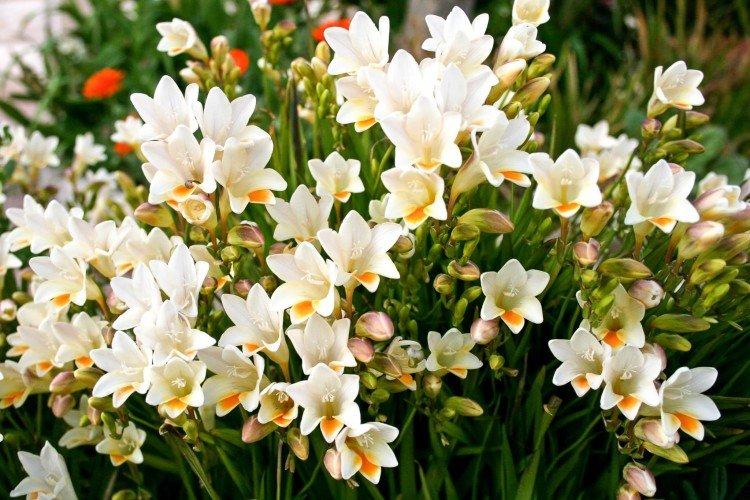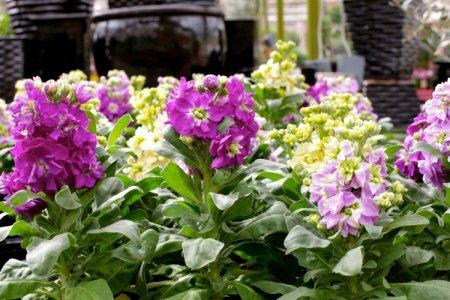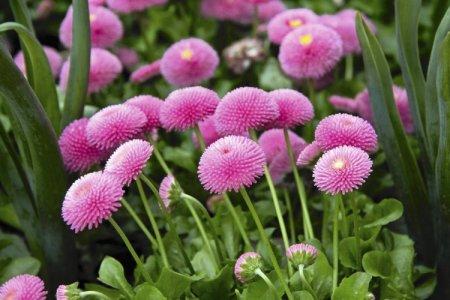
Spectacular and lush inflorescences on thin stems, a delicate aroma, a variety of colors are the main reasons why freesia growers all over the world adore freesia. To make her grow really beautiful and healthy, you have to work hard. Let's tell!
general information
Freesia is a herbaceous perennial that came to us straight from South Africa. It is known for its delicate floral scent with woody and citrus notes. Freesia came to Europe about 300 years ago, and for a long time remained a rare noble flower.
The root system of freesia is a corm, and it belongs to the iris family. In its natural environment, it grows in humid places among bushes and along roads. Branched bushes grow up to 1 m and are densely covered with one-sided inflorescences up to 5 cm in length.

Freesia types
The genus of freesia includes about 20 varieties, but among gardeners, hybrid varieties are most often used. In any case, let's try to figure it out in more detail!
Freesia Armstrong
The same species that became the basis for most modern hybrids. This is a medium-sized freesia up to 70 cm tall with bright red or pink inflorescences of 3-5 bells.

White freesia
It is also called broken, and it is a very compact but very graceful look. The height of thin shoots does not exceed 40 cm, but at the same time they are crowned with large paniculate inflorescences of 2-5 flowers.

Fragrant freesia
One of the most fragrant varieties with a distinct lily of the valley scent. In addition, fragrant freesia has very voluminous inflorescences, up to 7 bright yellow buds in each.

Hybrid freesia
This category includes almost all of the current riot of colors and shapes. The diameter of individual flowers reaches 7 cm, and they can even be two-colored and variegated.

Freesia care
Freesia is quite capricious and sensitive, so there are no minor trifles in caring for it - from soil temperature to digging out the bulbs. But it pays off in full with her beauty!
Temperature
Freesia does not like heat, cold and sudden temperature changes. Due to cold snaps, its growth slows down, and in a hot period it actively grows leaves, rather than flowers. If the temperature drops below +3 and rises above +22, empty deformed buds appear.

Lighting
Freesias need constant, but not overly aggressive sunlight. Direct rays during peak hours can cause burns, especially in the southern regions. But even in the shade, the plant will never bloom magnificently and brightly.

Watering
During the growth of freesia, you need regular and abundant watering at the root, but you cannot wet the buds. On too dry days in the evening, gently spray the leaves and shoots. Always mulch the soil to maintain optimal temperature and humidity conditions.

The soil
For freesia, you need a nutritious, loose and always warm soil. We recommend adding compost and mineral fertilizers in advance. Dolomite flour will help get rid of high acidity.

Fertilizers and feeding
Due to the sensitivity to soil salinity, freesia is fertilized only with liquid mixtures. In the period of active growth, choose complex formulations with a high nitrogen content. The first top dressing is applied after germination, and the next - every 2 weeks.

Pruning
Freesia is often grown to be cut for bouquets. In this case, it can be cut immediately after the first flower has blossomed. In other situations, remove the withering buds so that the bulbs do not waste energy.

Support
Thin stalks of freesia easily bend under the weight of large buds. Severe deformation can lead to the fact that they simply break. Therefore, for tall varieties, it is recommended to use supports as soon as they grow up to 15 cm.

Transfer
Freesia cannot be transplanted during growth and flowering.Even if something went wrong with the selected site, it is better to just take this into account next year and choose a new one.

Wintering
In October, the freesia leaves will start to turn yellow, and you can also cut off the ground part and dig up the bulbs. After disinfection and drying, they are stored in a paper bag in a moderately humid room at 12-15 degrees, and a month before landing in open ground, lower the temperature to +10.

Planting and breeding
The easiest way to propagate freesia is bulbous. Bulbs can be planted in the ground not earlier and not later than mid-April, because both too cold and too warm soil are detrimental to the sprouts. Dig them into flowerpots a couple of weeks before. Depending on the size, the bulbs are planted at intervals of 3-5 cm.
You can germinate freesia from seeds. To do this, they are laid out on a damp cloth or sand and left at room temperature in a dark room. Seedlings will appear in about a month with regular spraying. After the appearance of 2 leaves, they can be planted in pots, and with the arrival of heat, they can be planted in the garden.

Freesia pests and diseases
Freesia is often attacked by aphids, spider mites and thrips, but this is not so scary, because ordinary insecticides help them. Much more dangerous for delicate bulbs and shoots is rot and fungal diseases. In particular, fusarium and scab.
The reasons can be different - poor planting material, improper storage of bulbs, violation of agricultural technology. In the early stages, fungicides can still help, but in case of severe damage, it is better to remove the plant and process all the plantings around. Be sure to disinfect the bulbs after digging and before planting.

Freesia - photo
If it seemed to you that caring for freesia is too laborious - do not rush to conclusions. First take another look at this beauty!



























